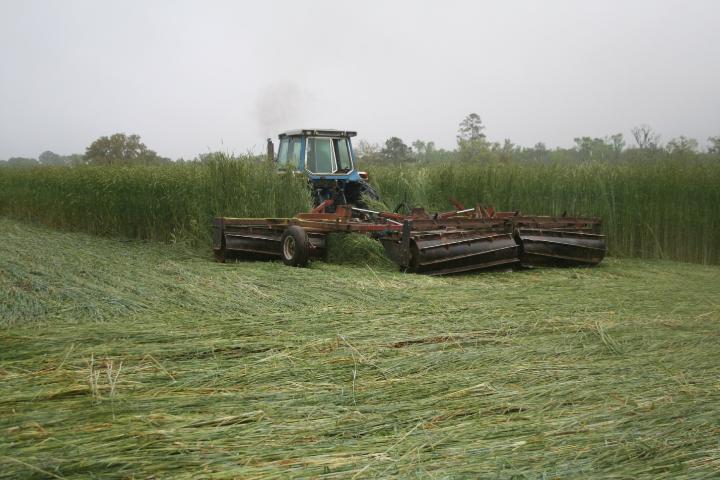Title: Rolled-crimped winter rye cover effects on hand-weeding times and fruit yield and quality of cucurbits
 Abstract: Pesticide-free vegetables are in demand at farmers’ markets featuring locally grown products. Weeds often are deleterious in such crops, and managing them without herbicides is difficult. Stale seedbeds and rolled-crimped winter rye (Secale cereale L.) cover crops are non-chemical methods that may help manage weeds effectively. These methods were compared over two growing seasons as they affected fruit yield, fruit quality, and hand-weeding times in west-central Minnesota for transplanted cucumber (Cucumis sativus L.), pumpkin (Cucurbita pepo L.), and watermelon (Citrullus lanatus [Thunb.] Matsum. &Nakai). Cumulative hand-weeding times were 82-85 hr·ha−1 in stale seedbed systems but 5-18 hr·ha−1in rolled-crimped rye mulch systems. Evenwithout hand-weeding, cucumber yields and quality scores in rye mulch were similar to those in stale seedbeds augmented with preemergence herbicide and hand-weeded. Pumpkin yields were reduced by 25% in rye mulch systems, but quality was not affected. Watermelon had yield reductions up to 75% in rye mulch compared to stale seedbeds with weed control. Cucumber, pumpkin, and watermelon have high, moderate, and low potential, respectively, for herbicide-free production in rolled-crimped winter rye mulch in cold-temperate growing regions. [Frank Forcella, James Eklund & Dean Peterson (2014). Rolled-crimped winter rye cover effects on hand-weeding times and fruit yield and quality of cucurbits. International Journal of Vegetable Science, online 12 August] Comment
Abstract: Pesticide-free vegetables are in demand at farmers’ markets featuring locally grown products. Weeds often are deleterious in such crops, and managing them without herbicides is difficult. Stale seedbeds and rolled-crimped winter rye (Secale cereale L.) cover crops are non-chemical methods that may help manage weeds effectively. These methods were compared over two growing seasons as they affected fruit yield, fruit quality, and hand-weeding times in west-central Minnesota for transplanted cucumber (Cucumis sativus L.), pumpkin (Cucurbita pepo L.), and watermelon (Citrullus lanatus [Thunb.] Matsum. &Nakai). Cumulative hand-weeding times were 82-85 hr·ha−1 in stale seedbed systems but 5-18 hr·ha−1in rolled-crimped rye mulch systems. Evenwithout hand-weeding, cucumber yields and quality scores in rye mulch were similar to those in stale seedbeds augmented with preemergence herbicide and hand-weeded. Pumpkin yields were reduced by 25% in rye mulch systems, but quality was not affected. Watermelon had yield reductions up to 75% in rye mulch compared to stale seedbeds with weed control. Cucumber, pumpkin, and watermelon have high, moderate, and low potential, respectively, for herbicide-free production in rolled-crimped winter rye mulch in cold-temperate growing regions. [Frank Forcella, James Eklund & Dean Peterson (2014). Rolled-crimped winter rye cover effects on hand-weeding times and fruit yield and quality of cucurbits. International Journal of Vegetable Science, online 12 August] Comment
Keywords: Citrullus lanatus, Cucumis sativus, Cucurbita pepo, Secale cereale, cover crop, cucumber, pumpkin, watermelon, winter ryex
Original source
Article: WeedsNews5104 (
permalink)
Date: 28 August 2014; 10:29:28 pm Australian Eastern Standard Time
Author Name: David Low
Author ID: adminDavid
 Abstract: Pesticide-free vegetables are in demand at farmers’ markets featuring locally grown products. Weeds often are deleterious in such crops, and managing them without herbicides is difficult. Stale seedbeds and rolled-crimped winter rye (Secale cereale L.
Abstract: Pesticide-free vegetables are in demand at farmers’ markets featuring locally grown products. Weeds often are deleterious in such crops, and managing them without herbicides is difficult. Stale seedbeds and rolled-crimped winter rye (Secale cereale L.